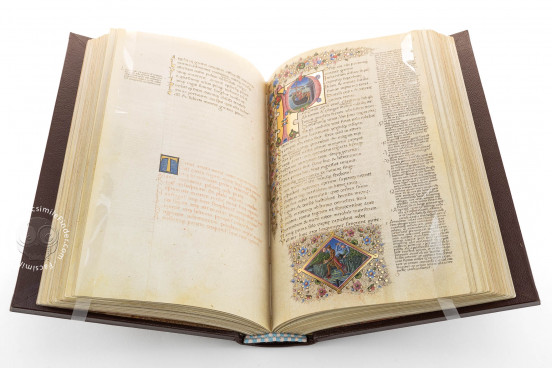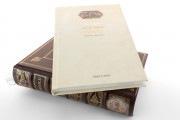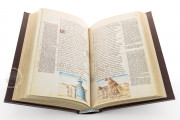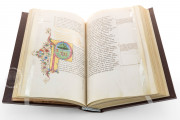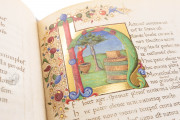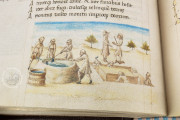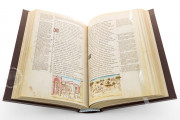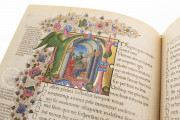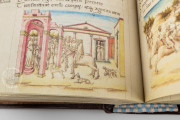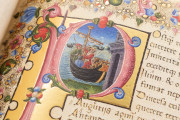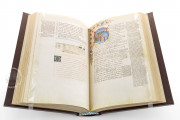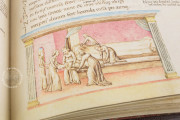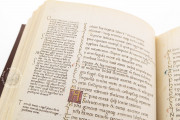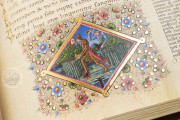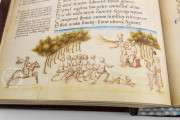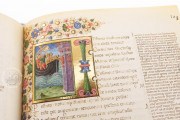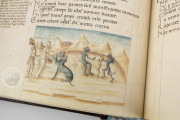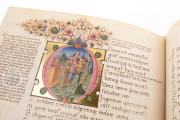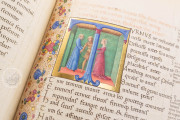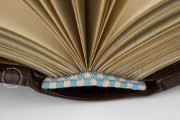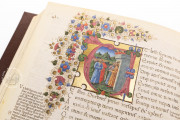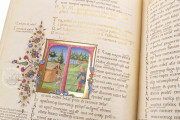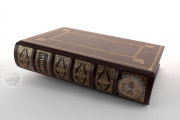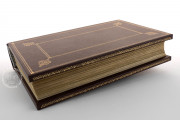The Sanudo Virgil is a deluxe illuminated manuscript of the works of the ancient Roman poet Virgil. It is named for Leonardo Sanudo, who copied the manuscript in Ferrara in 1458. Sanudo made payments to Gugliemo Girardi and Giorgio d'Alemagna in 1458 and 1459 to illuminate the volume. The manuscript boasts seventeen large historiated initials. Three are enhanced by elaborate foliate extensions into the bottom margin that include bas-de-page scenes. A series of sixty-three watercolor miniatures further illustrate the poet's longest and most famous work—the Aeneid—and a minor work, Pesto.
The historiated initials and their accompanying bas-de-page scenes, when present, are executed in bright colors and burnished gold leaf. The palette is dominated by purple and blue, and fleshy leaves and golden balls punctuate the marginal extensions of scrolling filigree.
The Artistic Milieu of the Este Court
Leonardo Sanudo was the Venetian ambassador to the court of Borso d'Este (1413-1471), Duke of Ferrara, Modena, and Reggio. Borso patronized (although not generously) many of the finest illuminators of the day, including Giraldi and d'Alemagna. Their painting in full color conforms to the prevailing style at the Ferrarese court.
D'Alemagna painted eight historiated initials in the Aeneid (fols. 60r, 72r, 85r, 96v, 108r, 149v, 161r, 188v), and Giraldi was responsible for the bulk of the illumination, including the remarkable narrative scenes in watercolor.
The Aeneid in Watercolor
Giovanni Giraldi brings the adventures of Aeneas to life in his watercolors, which are marked by dramatic narrative, a convincing illusion of three dimensions, and vivid settings reminiscent of contemporary Italian cities and countryside. The scenes are enriched with features seemingly plucked from fifteenth-century daily life, such as details of dress and attentive pet dogs.
Poetry and Commentary
Sanudo wrote a fine Humanistic Minuscule. Virgil's Latin hexameters (dating from the first century BCE) are presented clearly as verse, with the first letter of each line set off into the left margin. The commentary in the margins is by Servius (fl. 400 CE): it is written at half the scale of the main text. In all, the appearance is both scholarly and very attractive.
The Sun King Acquires an Italian Treasure
Sanudo presumably copied the Virgil for his own use. His coat of arms appears at the beginning of the Aeneid (fol. 60r). The manuscript was in the library of the French bibliophile Paul Petau (1568-1614), whose son, Alexandre Petau (d. 1672), dispersed the collection. It was acquired during the reign of Louis XIV (1638-1715), King of France, for the Bibliothèque royale (later the Bibliothèque nationale and, since 1994, the Bibliothèque nationale de France).
We have 1 facsimile edition of the manuscript "Sanudo Virgil": Virgilio. Bucoliche, Georgiche, Eneide, Appendix Vergiliana facsimile edition, published by Istituto dell'Enciclopedia Italiana - Treccani, 2017
Request Info / Price
